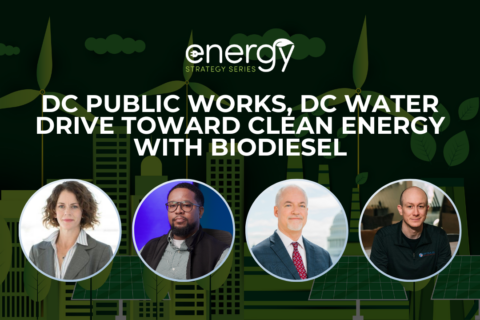The United States is in the midst of a transformative period when it comes to energy production and efforts to mitigate the effects of climate change.
And lot of the changes are happening in the Washington, D. C., region.
“We’re undergoing a big transition from a mostly carbon-based energy production system to a more renewable-based system,” Virginia Sen. Scott Surovell said. Surovell, whose 34th District includes much of Fairfax County, has been heavily involved in energy issues.
“There’s no doubt the energy industry is in a period of dynamic evolution,” added Jim Steffes, senior vice president regulatory and public affairs with Washington Gas. “We hear clearly that our customers want energy to be affordable, reliable, safe and secure.”
We talked with the Virginia Senate majority leader and Steffes, about local energy initiatives and challenges for WTOP’s Energy Strategy Series 2024.
Energy demands on the rise in D.C. region
The Democratic lawmaker pointed out that Virginia is been about 30% nuclear, with the remaining 70% carbon.
“To accommodate all these new-generation sources, we basically need to rebuild our grid and redesign our grid so that we can move energy around the commonwealth in a different way than we historically have,” he said, noting that presents various challenges.
Surovell noted that northern Virginia has experienced a lot of growth, owing in part to addition of data centers. The demand for electricity is “exploding,” he said.
That adds to the pressure on state lawmakers to help make sure that costs are spread fairly across everyone, Surovell said.
One critical factor is bringing on staff who understand and can help with these complex issues on legislative teams. But more full-time staff have been added to help deal with things like utility regulation, Surovell said.
For his part, Steffes credited Surovell and the Virginia legislature for “leading the country in many ways” when it comes to energy issues.
A top goal is “ensuring that our customers’ voices are heard and represented at all levels of government,” Steffes said, adding, “We also know that our customers really want us to help them pave the way for new and innovative ways they can help the region meet its climate goals.”
Creating clean energy
Surovell this year proposed a bill to establish the Virginia Clean Energy Innovation Bank, which would allow the state to tap into federal funds to help accelerate clean energy projects.
The “green bank” would provide grants, loans and credit enhancements, similar to institutions created in other states, including Minnesota, he said.
“The idea was to leverage a very small amount of state money into a really big pile of federal money, investing in these projects … which might otherwise be hard to finance,” he said.
Surovell said the window for federal funds closes in a few years, so he believes the legislative needs to be enacted soon.
Virginia Gov. Glenn Youngkin recently proposed revisions in the legislation, but Surovell hopes the idea will eventually take hold.
Previously, he successfully got a bill passed by the General Assembly that helps to reduce methane emissions, which he said contribute to roughly one-third of the climate problem. The legislation, passed in 2022, incentivizes utility companies to capture methane and use it as a renewable energy source.
“It did basically three things,” he said. “One, it allowed [utilities] to recover from their customers the cost of using enhanced leak detection technology — things like drones … or other sorts of newer ways of seeing methane coming out of their pipelines.”
Second, Surovell said it authorized natural gas companies to purchase certified, low-emission methane.
And third, it encourages natural gas companies to invest in biomethane projects.
“You can put a methane capture system on a landfill,” which he noted Washington Gas has been involved in through various projects.
Discussing one project, Steffes said that Washington Gas will soon own and operate an interconnecting pipeline to accept and transport renewable natural gas from a biogas production facility at the Prince William County landfill.
“This biogas facility is expected to provide an approximately 30% reduction in greenhouse gas emissions from the landfill itself right now,” Steffes said. “That’s the equivalent of more than 70,000 gas-powered vehicles per year in Virginia.”
He added that “balanced, thoughtful engagement with policymakers” on issues related to climate is very important as long as utilities don’t sacrifice safety, affordability, reliability and security.
Replacing aging energy infrastructure across D.C. region
Surovell said that for well over a decade Washington Gas has been replacing pipelines, and he’s generally pleased with how these projects have evolved.
The State Corporation Commission (SCC) in 2011 approved the company’s initial application for a replacement program known as the SAVE Act.
“I know, for example, in my neighborhood they came through and did a whole bunch of pipes about two years ago,” he said. “And you know, it’s important that we continue to renew this infrastructure.”
Steffes pointed out that more than 40 states and the District of Columbia have accelerated pipeline replacement programs. In D.C., the Washington Gas program is called PROJECT pipes, and in Maryland, it is the STRIDE program.
Over the past decade, Washington Gas has upgraded over 35 miles of pipeline and thousands of services across the utility’s community footprint through these programs to reduce risk and build a reliable system, Steffes said.
“The added benefit is we’re replacing our most leak-prone infrastructure and most leak-prone pipelines,” he said. “And what this also does is it reduces methane leaks.”
Over time, that can help reduce hundreds of thousands of metric tons of greenhouse gas, Steffes said
A ‘balanced approach’ to energy
Surovell and Steffes said energy policy doesn’t have to be an either/or approach when it comes to electrification and fossil fuels.
“Saying there’s only one pathway forward does not recognize the reality of the challenges it takes to run energy infrastructure,” Steffes said.
He noted that Washington Gas supports a “balanced approach to helping this region meet its energy and climate goals.”
Steffes said that the regional electricity grid, which includes Virginia, Maryland and D.C., is powered mainly by natural gas, nuclear power and coal.
“Today, especially on the coldest night when there’s no solar, our customers are using natural gas to heat their homes, so we could push back on the assertion that mandated forced electrification, as it stands today, (which) often people say is the best or only pathway to our future,” he said.
Steffes also said Washington Gas is committed to energy efficiency and has worked closely with officials in Virginia and Maryland on policy efforts. He added that the utility would like to do more in D.C. as well.
To discover more ways that governments, nonprofits and businesses are innovating to reimagine approaches to energy use, go to WTOP’s Energy Strategy Series 2024.







